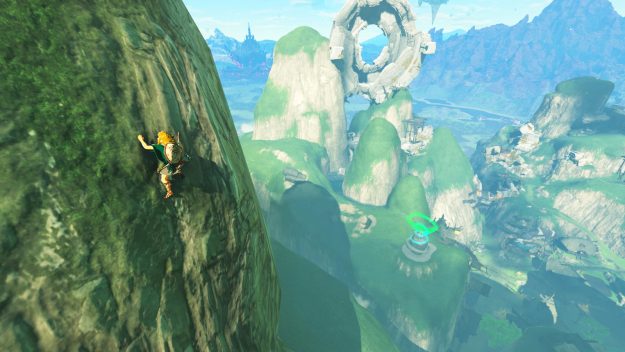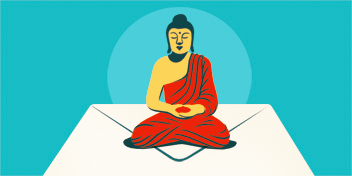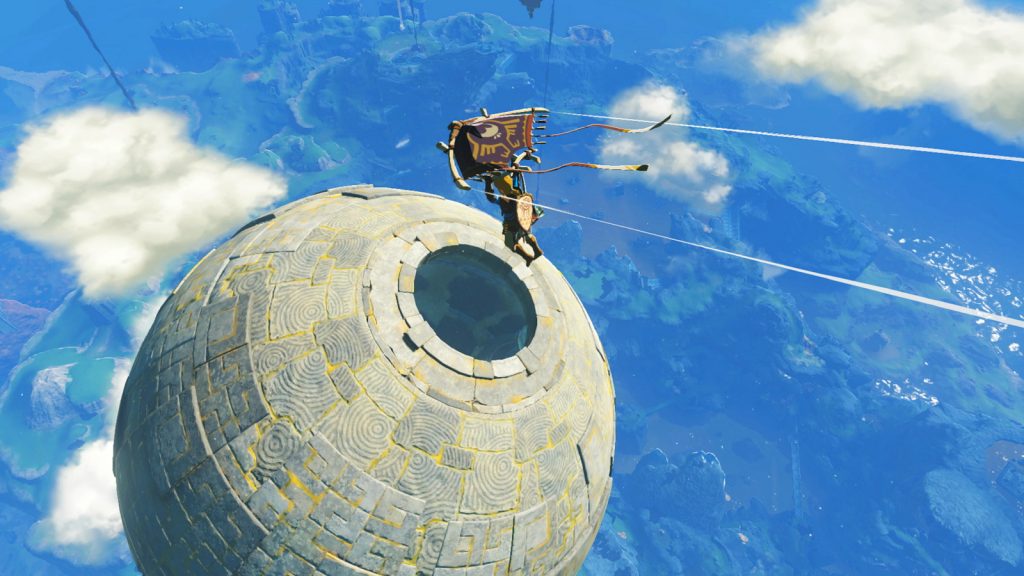Evil incarnate, looming apocalypse, the heroic team-up of a magic-wielding princess and a pure-of-heart knight. It’s a tale as old as time—or at least as old as 1986, when Nintendo released the first Legend of Zelda game, marking the start of what would become one of the most widely recognizable and critically acclaimed video game franchises to date. This May, Nintendo released the highly anticipated nineteenth installment in the franchise, titled Tears of the Kingdom—and, more or less, the plot remains unchanged from the previous eighteen. Some may call it lazy rehashing. I call it a mark of samsara.
Tears had some big shoes to fill. Its 2017 predecessor, Breath of the Wild, was heralded as a near-perfect game, and Tears recycles both Breath’s engine (the coding framework that the game runs on) and its map of Hyrule, a sprawling kingdom that is as much of a character as Link—the game’s protagonist and sworn protector of Hyrule’s princess, Zelda. As the game opens, Link and Zelda are exploring ancient ruins beneath Hyrule Castle and accidentally stir an ancient slumbering evil. Link is knocked unconscious, awakening some time later with Princess Zelda nowhere to be found and a dusty old mummy-ghost arm in place of his own.
But it ain’t just dusty, old, and mummy-ghost-y—the spirit of the arm’s original owner, who happens to be the first King of Hyrule, bestows Link with some nifty magical powers to aid him on his quest. They’re not quite what you’d typically expect from a fantasy game—they’re more like tools for interacting with the game’s physics-based world. One lets you telekinetically grab almost any object in the game and fuse it to something else. Another lets you reverse an object’s passage through time. Need to get across a chasm? Try breaking some trees and fusing a couple of logs together. Or move one log across, bring it back, jump on it, and reverse its pathing.
After a brief tutorial section to introduce players to the new bag of tricks, Link is told to visit four major Hyrulian cities. But it’s more of a suggestion, really—at this point, you’re pretty much free to do as you please. And damn is it fun.
It’s hard to describe how expansive and alluring the game’s world is, but imagine being dropped in an interactive Miyazaki film—that pretty much sums it up. Hyrule is just as gorgeous as it was in the last game, with stunning environments that vary from rolling dunes and sand-swept ruins to frigid, mountainous expanses; from lush green plains to volcanic crag. But with Tears’s additional two maps—one below Hyrule and one above—what was already a massive game world to begin with has been tripled. Sky Islands dot the horizon, while below Hyrule lie The Depths—a nearly pitch-black, sprawling void that curiously mirrors the terrain of the surface world (mountains become valleys; valleys, mountains).
Given the open-world, nonlinear format of the game, you can easily ignore the game’s main story and spend hours simply wandering. But in a way, that is the main point of the game: every mountain, every cave, every lake is fully explorable, and you are intentionally given tools to do just that—climbing, swimming, hang gliding. The game rewards you for treating its world with the same care that it was crafted with—for taking the time to investigate and appreciate all of your surroundings, no matter how unimportant they may seem. All sorts of hidden treasures, puzzles, and whimsical side characters can be uncovered by the inquisitive and attentive player.
That feeling of adventure—of a world filled with mystery and awe and the simple urge to explore and appreciate it—is the core of the game. Creator Shigeru Miyamoto says that the series is imbued with his childhood memories of adventuring through the forests, caves, and “secret doors and pathways” of his hometown, Kyoto.
Perhaps our heroes are just as responsible for the apocalypses they continually avert.
The world we explore in Tears is also directly modeled on Kyoto: “I took a map of Kyoto and overlaid it on the game world, and I tried to imagine going to places that I know in Kyoto,” director Hidemaro Fujibayashi said about designing Hyrule for Breath of the Wild. “You have all of these famous temples and shrines and whatnot. . . . [I]t made it really easy to envision how that would translate to the game map,” art director Satoru Takizawa added.
The exploration is almost necessary. In order to increase Link’s maximum health, players must find Shrines of Light—of which there are a whopping 152 scattered across the map. When I ran into my first group of tougher enemies, I quickly realized that I needed more health to stand a chance. So I made my way up to the highest nearby vantage point, opened up my hang glider, and charted a course for all the shrines that I could see. It was hard not to feel like Basho, wandering the countryside from shrine to shrine on my own pilgrimage of sorts.
Resembling real-life Shinto rock shrines, each Shrine of Light transports players to a puzzle. Some are trickier than others, but all put your perception, creative problem-solving, and mastery of the game’s core mechanics to the test. Because there are so many ways to approach the game, it can be tough to find the appropriate solution. I’ve caught myself stubbornly throwing one method at the wall over and over again, trying to force the puzzle into submission. But when I notice that frustration, I can take a step back, clear my head, and try it a different way—and voilà! The solution is right there, clear as day—a stark reminder of Suzuki Roshi’s beginner’s mind: “If your mind is empty, it is always ready for anything; it is open to everything. In the beginner’s mind there are many possibilities; in the expert’s mind there are few.”
It’s a concept that applies to the game’s combat too. Every weapon has a set durability, meaning that they’re bound to break after felling just a few baddies—a mechanic that reeks of impermanence. But you can also fuse items to your weapons on the fly for different effects. Sure, you can fuse plenty of stuff onto your weapons to just make them hit harder. But for the creative player, this mechanic provides endless ways to approach combat. If there are monsters standing in water, try attaching a Shock Fruit to an arrow to stun them. Or put an Ice Fruit on a spear to freeze enemies and keep them at bay.
And then there’s one of the game’s most compelling new features: robotic engineering. Man and machine convene—players can collect various basic components (a steering wheel, a fan, a flame emitter) and combine them however they please. If you’re resourceful, you don’t even have to fight at all—you can just build a giant mech to do it for you. Or if you’re in a rush to explore a cave, you can just barely see partway up a mountain, build yourself a hot air balloon, or maybe a hovercraft.

Though Tears excels in its gameplay and environmental storytelling, its plot is by far its weakest point. Yes, there are fun characters and a couple of unexpected turns, and the plot is certainly enjoyable enough, but overall it’s much the same as the other installments: Link and Zelda fight the big bad to save Hyrule.
But if it ain’t broke, don’t fix it. (Or if it is broke, fuse it back together.)
And there’s a reason the series can get away with it: the games aren’t really telling the story of Link and Zelda, but rather a Link and a Zelda—two entities stuck in samsara, doomed to repeat a never-ending battle between light and dark, good and evil.
Skyward Sword, the series’s 2011 installment, follows the pair’s first iteration. They battle the demon king Demise, an “eternal being” that has “conquered time itself.” Having previously been defeated by the Goddess of Light—who we learn Zelda is the mortal incarnation of—Demise is out for vengeance. When the duo finally best him at the end of the game, he utters the curse:
My hate . . . never perishes. It is born anew in a cycle with no end! I will rise again! . . . An incarnation of my hatred shall ever follow your kind, dooming them to wander a blood-soaked sea of darkness for all time!
In a 2021 paper titled “I Coveted That Wind: Ganondorf, Buddhism, and Hyrule’s Apocalyptic Cycle,” University of Pennsylvania professor Kathryn Hemmann dissects the lines in their original Japanese. The word translated above as “hatred” originally reads as on’nen, a Japanese Buddhist term “used to refer to the effect of lingering hatred within the cycle of samsara”; the word “incarnation” was translated from gonge, a term used by the heavily syncretic Shugendo sect to describe Shinto deities as “temporary manifestations that a Buddha or bodhisattva takes in order to save living beings.”
The “curse” is more of a warning: the karmic repercussions of striking down hatred—of hating hatred—ensure that it will rise again, just as its return ensures that our heroes (or iterations of them) will be around to usher in a new era of peace. Perhaps Demise and his gonge are indeed bodhisattvas, for without the apocalyptic decline that they bring, there is no great renewal—and perhaps our heroes are just as responsible for the apocalypses they continually avert.
It’s a profoundly Buddhist metanarrative that mirrors the cyclical cosmologies found in various schools: from kalpa to kalpa, the “good” perpetuates samsara just as much as the “evil” does. I say bring the kalpas on—so long as Nintendo keeps delivering these delightful Zelda games.
Thank you for subscribing to Tricycle! As a nonprofit, we depend on readers like you to keep Buddhist teachings and practices widely available.

